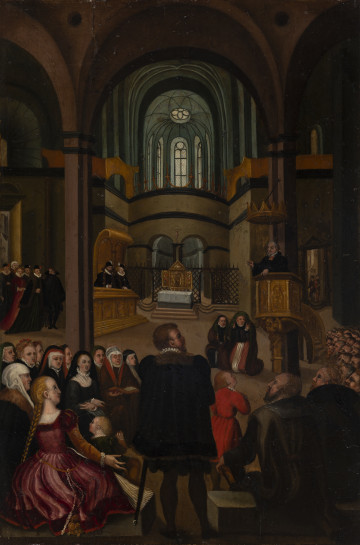
Kazanie w kościele ewangelickim | Sermon in a Protestant church
3. ćwierć XVI wieku
National Museum in Szczecin
Part of the collection: European classics of modernity
Until 1918, Bolesław Cybis studied at the Art School in Kharkov, where he became associated with the environment of young avant-garde painters and sculptors. In 1918, he published works in this vein in the almanac Semplius tri (Seven plus three). In addition to painting, he was absorbed by the visual arts of the theatre, for which he began to regularly design sets during the Istanbul period (1920-1923). Between 1923-1926 and 1933-1934, Cybis supplemented his education at the School of Fine Arts in Warsaw under the guidance of Tadeusz Pruszkowski and Władysław Skoczylas. As a student of Pruszkowski's, he joined the St. Luke Brotherhood, founded by the professor in 1925, and following the master's example, he turned to historical inspirations: the Italian Renaissance, as well as Spanish, Flemish and Dutch Baroque. He was particularly influenced by a 10-month trip to Italy in 1930. On the way, in Vienna, he saw the masterpieces of Pieter Breughel the Elder and Dieg Velázquez. He also admired the canvases of the latter during a guest exhibition at the Prado Museum in Rome. Distinctive features of the Spanish workshop - pietism in rendering details of the costume, hieratic gestures or verisimilitude of facial expression and complexion - entered Cybis's repertoire, arousing great interest of the public. A typical example of the artist's mature style is the image of a lady from the Szczecin collection, created just after the completion of his academic studies and the great success of the Brotherhood at the Venice Biennale. The context of official Italian, German and Soviet art inscribed Polish aspirations into the pan-European conservative turn in the culture of the 1930s. Although Cybis discarded his avant-garde, expressive facets, some of his formal and thematic interests had remained unchanged since his time in Kharkov: his fascination with transparent matter, his linear-haptic elaboration on the illusion of space, his fondness for the bourgeois portrait genre.
Szymon Piotr Kubiak
Author / creator
Dimensions
cały obiekt: height: 165 cm, width: 110 cm
Object type
painting
Creation time / dating
Creation / finding place
Identification number
Location / status

3. ćwierć XVI wieku
National Museum in Szczecin
1819
National Museum in Lublin
1819
National Museum in Lublin
DISCOVER this TOPIC
Museum of King Jan III's Palace at Wilanów
DISCOVER this PATH
Educational path